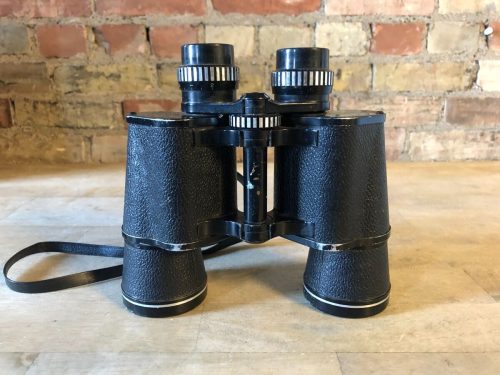When exploring the moon’s craters, spotting distant planets, or observing the sparkling star clusters, the right pair of binoculars can transform your stargazing sessions into a breathtaking adventure. The best binoculars for stargazing allow you to connect with the vastness of the universe and we are here to walk you through the high-performance models available on the market.
While telescopes often take the spotlight as the go-to tool for night sky observation, binoculars can offer a unique and accessible way to enjoy celestial views. They are not only portable but also easy to use, making them an excellent choice for beginners and seasoned stargazers. Besides, the right binoculars will let you observe celestial objects in greater detail, enjoy a wider field of view, and explore the night sky without fatigue.
This guide will take you through the top-performing binoculars for stargazing that deliver sharp, bright, and clear views. We will also cover the key factors to consider when choosing binoculars for stargazing, such as magnification, aperture size, optical quality, and portability.
Best Binoculars for Stargazing
Whether you’re an amateur astronomer or simply looking for a new hobby, below are binoculars that can significantly enhance your experience under the stars and help you make the most of your stargazing journey. Let’s take a look.
1. Maven B5 56 mm FL Binoculars (18X56) – Best Overall
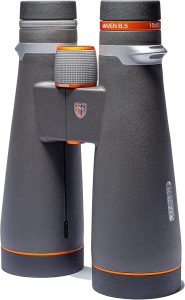
Specifications
- Magnification: 18x
- Objective Lens Diameter: 56mm
- Prism Type: Abbe-Koenig
- Exit-Pupil Diameter: 5.6mm
- Focus Type: Center Focus
- Diopter Adjustment Range: +/- 4
- Eye Relief: 18 Millimeters
- Weight: 45 oz
The Maven B5 56 mm FL Binoculars (18×56) are the best binoculars for stargazing. They are designed and built with high-end optics that render unparalleled performance.
One of the standout features of this model is its incredible 18x magnification, which brings distant subjects into sharp, vivid focus. The 56 mm objective lens allows for excellent light gathering, making the binoculars ideal for low-light conditions like dawn or dusk.
Furthermore, the field-flattening lenses ensure a clear and sharp image across the entire field of view, minimizing any distortion. Combined with Maven’s extra-low dispersion (ED) glass, the color fidelity and contrast are top-tier, offering a true-to-life viewing experience.
Sturdy construction from durable materials is another strong point of the Maven FL binoculars. They are also both waterproof and fog-proof for use in any weather condition.
Ergonomically, the B5 fits comfortably in hand despite its larger size, and the grip is solid even in wet conditions. Over and above that, the focus wheel operates smoothly, allowing for precise adjustments, and the adjustable eyecups accommodate users with glasses.
Pros
- Premium build quality
- Superior optical performance
- Smooth focus wheel
- Long eye relief
Cons
- Big budget
2. Celestron – SkyMaster 25×100 Binocular – Best Value
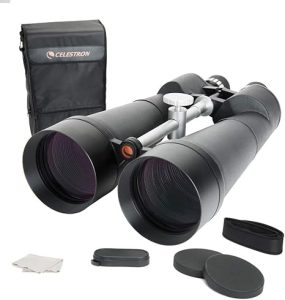
Specifications
- Magnification: 25x
- Objective Lens Diameter: 100mm
- Exit-Pupil Diameter: 4mm
- Focus Type: Individual Focus
- Diopter Adjustment Range: ±15
- Eye Relief: 15 Millimeters
- Relative Brightness: 16
The Celestron SkyMaster 25×100 are high-powered binoculars optimized for astronomy. These giant binoculars feature massive 100mm objective lenses and powerful 25x magnification that make them ideal for long-distance viewing of land-based subjects or astronomical observing at night.
This pair of binoculars is built with user-convenience in mind. It comes with a tripod adapter to mount in on a tripod for shake-free views. Over and above that, the binocular features BaK-4 prisms that maximize light throughput to your eye so you see brighter, more detailed images.
Another stand-out feature of this optic is its durable construction. It boasts a rubber-armored housing with a secure gripping surface. The water-resistant exterior stands up to tough conditions and unexpected rainy weather for all-weather use.
Other noteworthy features included are an objective lens cap, a rain guard, carrying case, neck strap, lens cloth, and instruction manual for better viewing.
Pros
- Soft, rubber eyecups for comfortable glassing
- Durable and reliable construction
- Numerous handy accessories included
- Good value for the price
Cons
- Heavy
3. Sogries 18X70 High Power Binoculars -Best for Eyeglass Wearers

Specifications
- Magnification: 18x
- Objective Lens Diameter: 70mm
- Prism Type: BAK-4 Prism
- Eye Relief: 29 Millimeters
With the high 18X magnification and 70mm large objective lens, this Sogries pair of binoculars offer a unique opportunity to experience the world in a new light. It provides a level of detail, clarity, and breadth of view that to satisfy and delight users of all interests
The selling point of this binocular is its optical clarity. It is designed and built with BAK-4 prisms, a key factor in delivering bright, sharp views and enhanced low-light performance. Additionally, the high-quality optics provide a viewing experience that is rich in detail and vividness, making your observations more enjoyable and informative.
More importantly, these high-powered binoculars are engineered to deliver a superior viewing experience while withstanding the challenges of outdoor use. Their daily waterproof body, rubber-coated finish, and IPX7 standard compliance make them a reliable and versatile tool for anyone who enjoys exploring the great outdoors.
Well, that’s not all. With 1/4 thread binocular tripos adapter, you can enjoy a more relaxed and precise observation, leaving your hands free to focus on other tasks or simply to relax during long periods of viewing. Smartphone Adapter is designed to fit a variety of eyepieces, from 29 millimeters to 45 millimeters (2.09″-3.54″)in diameter. The binocular also fits eyepieces with Diameter 1.18″-2.52″, making it highly adaptable for different types of optical devices.
Pros
- Superior optical clarity
- Relatively lightweight
- Generous eye relief that is eyeglass-friendly
- High performance for a wide range of activities
Cons
- The focus system is not that smooth
4. Athlon Optics 12×50 Argos G2 HD Gray Binoculars- Best for Family Use
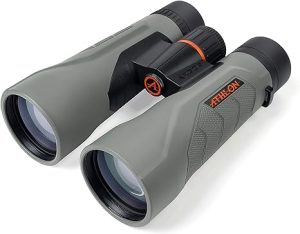
Specifications
- Magnification: 12x
- Objective Lens Diameter: 50 mm
- Close Focus Distance: 4m/13ft
- Field of View: 257ft/1000yards
- Focus Type: Center Focus
- Weight: 31.5 oz
- Size: 6.8″ x 5.6″
The Athlon Optics 12×50 Argos G2 HD Gray Binoculars offer exceptional clarity and performance, making them a top choice for stargazing and other outdoor activities. These binoculars are reasonably affordable and easy to use for both adults and kids hence suitable for families.
The 12x magnification and 50mm objective lenses strike a balance between powerful zoom and light-gathering capability, making them versatile for long-range viewing without sacrificing image quality. Besides, the large field of view, at 271 feet at 1000 yards, ensures you won’t miss any details while the fully multi-coated lenses and HD glass provide bright, crisp images with excellent color fidelity even in low-light conditions.
The build quality of the binoculars is a force to reckon with. They boast a durable magnesium chassis that is lightweight but strong, with a rugged rubber armor coating to ensure a secure grip and added protection against the elements. Furthermore, the optical tubes have a weatherproof design that includes argon purging and O-ring sealing to ensure reliable performance in all weather conditions.
Comfort and ease of use are the other key strengths of the Argos G2 HD binoculars. The twist-up eyecups are adjustable for those who wear glasses, and the long eye relief (17mm) allows for extended viewing sessions without discomfort. Weighing just 30 ounces, these binoculars are also easy to carry, and the included neck strap and carrying case add convenience.
Pros
- Great value for money
- Bright and clear image views
- Solid and reliable construction
- Ease of use
Cons
- Comparatively heavy
5. UncleHu 20×50 High Power Binoculars – Best Budget
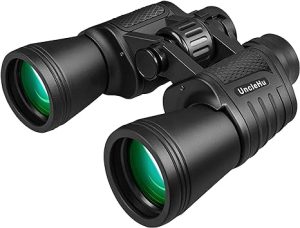
Specifications
- Magnification: 20x
- Eyepiece Diameter: 26mm
- Objective Lens Diameter: 50 mm
- Focus System: Center Wheel and Right Rye
- Lens Coating: Fully Multi-coated Green Membrane
- Type of Prism: BAK4
- Field of View: 56m/1000m
- Weight: 800g
As one of the best binoculars for stargazing, the UncleHu 20×50 High Power Binoculars are available at a price that is hard to pass. Though inexpensive, these binoculars are rich in features that you need to enjoy stargazing.
The 6mm eye lens diameter work in tandem with the 50mm objective lens diameter to deliver clear and bright views. Perfect binoculars for adults bird watching, hunting, camping, hiking, sports and stargazing.
Furthermore, the multiple layer coated aspherical lenses elements boost light transmission and minimize distortion, resulting in better image brightness, contrast and quality, even in low light condition. The Bak-4 prism also has a perfectly round exit pupil so you can have a clear vision at dusk or at night.
Construction-wise, the binoculars feature a metal structure that is durable yet ultralight at 1.76lb (800g) only. The rubber finish ensures shock resistance and a firm, comfortable grip during use. Moreover, the binoculars are anti-drop, fog-proof, and waterproof, but can not be used in a heavy rain for a long time or soaked in the water.
Regarding focus, the binocular features a right eyepiece focus wheel and center wheel that are super easy for anyone to use. This pair of binoculars can also be used with a tripod so it is very convenient when you are stargazing for a long time.
Pros
- Tripod ready
- Lightweight design
- Clear vision
- Excellent build quality
- Budget-friendly
Cons
- Unstable eyepiece
What Binocular Size Do You Need?
When choosing binoculars for stargazing, magnification and aperture size are key factors. Both should be balanced to ensure optimal performance. .
For magnification, binoculars with 12x to 15x magnification are the most popular. They offer more detailed views of the moon, star clusters, or planets. However, they may require a tripod or very steady hands due to the increased image shake. High-powered binoculars such as 18x or 20x are also common and they provide even greater detail. However, they are best suited for deep sky observations and always require a tripod due to their size and weight.
The ideal aperture for stargazing is 50mm and above. The larger the aperture, the more light the binoculars gather allowing for clearer and brighter views of celestial objects.
Read Also
- 7 Best Budget Binoculars for Astronomy
- 7 Best Night Vision Binoculars for Stargazing
- 7 Best Binoculars for Boating
How to Choose the Best Binoculars for Stargazing
The following are the key factors to consider when choosing the best binoculars for stargazing.
Quality of Optics
Binoculars made with high-quality glass, such as ED (extra-low dispersion) glass are the best for stargazing. They provide sharp and more color-accurate images by minimizing chromatic aberration.
With lens coatings, the best binoculars for stargazing should have fully multi-coated lenses that improve light transmission, brightness, and contrast.
Field of View (FOV)
A wide field of view allows you to observe more of the night sky at once, making it easier to locate celestial objects. For stargazing, a wider FOV is generally preferred, as it enhances the ability to view star clusters or constellations.
Eye Relief
This refers to the distance your eyes can be from the eyepiece while still seeing the full image. It is especially important for people who wear glasses to get binoculars with a long eye relief (15mm and above) for comfortable viewing over extended periods.
Build Quality and Durability
The build quality of binoculars determines their overall durability and longevity. The chassis should be crafted from hard-wearing materials and be armored with rubber for shock protection. It is also important that the binoculars be fully waterproof and fog-proof if you plan to use them in different environments. Even at night, humidity or dew can affect your binoculars, so waterproof and fog-proof designs are ideal.
Weight and Portability
Binoculars with larger apertures (for gathering more light) can be heavy. Consider the weight if you plan to hand-hold them for extended periods. Many stargazers opt for a tripod or monopod for larger binoculars, but if you want portability, lightweight binoculars can be easier to handle.
Interpupillary Distance (IPD) Adjustment
Ensuring the binoculars have adjustable IPD is important to match the distance between your eyes, providing the most comfortable and optimal viewing experience.
Focusing Mechanism
The next important thing to take into consideration is focus mechanism. A smooth and precise focusing mechanism is critical for stargazing. Stars are distant points of light, so being able to fine-tune focus for clarity is crucial.
Tripod Adaptability
If you opt for larger or heavier binoculars, ensure that they come tripod ready. The ability to mount them on a tripod will not only reduce hand shakiness but also give you a more stable and comfortable stargazing experience.
FAQs
- Which is better for stargazing, binoculars or a telescope?
Choosing between a telescope or binoculars for stargazing is largely a matter of individual preference. Binoculars are more portable, easy to use, and offer a wide field of view, making them great for beginners or casual stargazing. Telescopes on the other hand, provide higher magnification and are better for detailed observations. However they require more setup and can be more expensive.
- Should I use a tripod for stargazing with binoculars?
Yes. Binoculars with a magnification of 10x or higher will benefit from a tripod to reduce hand-shake and provide a steady view of celestial objects. Many binoculars come with tripod adaptors for easy setup.
- How much should I spend on binoculars for stargazing?
The cost of the best binoculars for stargazing varies depending on the brand and features incorporated. Entry-level binoculars suitable for stargazing range from $100 to $300, while higher-end models can go upwards of $500 to $1000 or more, depending on features like lens quality, coatings, and build.
Final Words
Investing in the best pair of binoculars for stargazing will enhance your glassing and make every expedition memorable. Remember that your glassing needs and budget will determine which model you choose. Look at the features that make each pair of binoculars the right purchase and choose accordingly.

